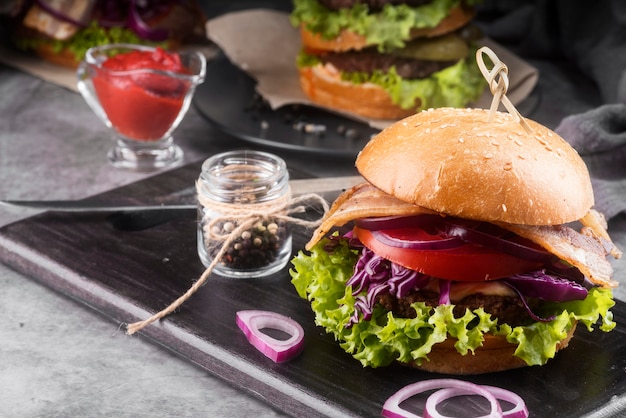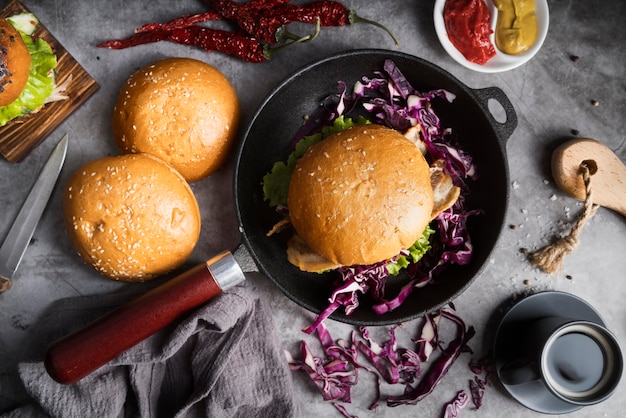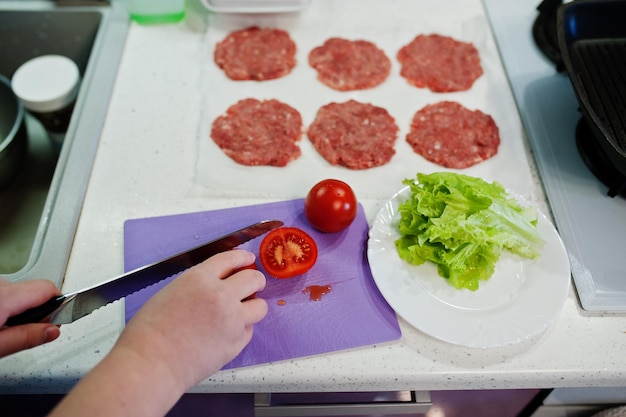Let's face it, the humble hamburger is a culinary icon. From backyard barbecues to gourmet restaurants, a good burger is a satisfying and delicious experience. But achieving that perfect patty – juicy, flavorful, and cooked to perfection – isn't always a walk in the park. It's all about nailing that internal temperature. And as someone who has spent years perfecting my burger-making skills, I'm here to share the secrets to achieving burger nirvana. Grab your tongs, fire up the grill, and let's delve into the world of burger brilliance.
(Part 1) The Importance of Internal Temperature

Why Temperature Matters
Imagine biting into a burger only to find it's either a raw, bloody mess or a dry, overcooked brick. Not exactly a culinary dream, right? The key to a satisfying burger lies in finding that sweet spot, that perfect balance between juicy and cooked. And the crucial element here is internal temperature.
Now, the USDA (United States Department of Agriculture) recommends cooking ground beef to an internal temperature of 160°F (71°C) to ensure it's safe to eat. But here's the thing: while that's a safe bet, it doesn't guarantee a delicious burger. Cooking to 160°F can leave you with a dry, gray patty that lacks the juicy, pink center most burger enthusiasts crave.
The Perfect Temperature Zone
This is where we dive into the fascinating world of burger temperature preferences. For those who like their burgers with a touch of pink, the magic happens between 130°F (54°C) and 145°F (63°C). This range ensures the burger is cooked through while still maintaining its moisture and tenderness, resulting in a juicy, flavorful bite. Now, I know what you're thinking: "Isn't that a little risky?" Well, while some people might prefer a well-done burger, cooking to this temperature range is completely safe. The key is to use a reliable meat thermometer to ensure the internal temperature reaches the desired level.
Of course, this is all about personal preference. If you prefer a well-done burger, aiming for 150°F (65°C) is a safe and delicious option. But remember, the goal is to find that sweet spot where safety and flavor collide.
(Part 2) Cooking Methods: Grill, Pan, or Oven

The Grill Master
For many, the grill is the ultimate burger throne. The smoky aroma, the char marks, the satisfaction of cooking over an open flame – it's a culinary experience that transports you to a blissful burger haven. But grilling burgers isn't just about throwing them on the heat and hoping for the best. It's about mastering the art of heat control.
The key is to maintain a moderate heat, avoiding direct flames that can lead to burnt exteriors and uneven cooking. A medium-high heat is ideal, allowing the burger to cook evenly without scorching the outside. And don't forget to use a meat thermometer to check that internal temperature – it's your guide to burger perfection.
The Pan-Seared Wonder
For those who crave a more controlled and consistent cook, the humble pan is a reliable companion. A trusty cast-iron skillet is perfect for searing burgers, creating a crispy crust and locking in those delicious juices. Heat the pan over medium-high heat before adding the burgers, ensuring a nice sear. Adding a tablespoon or two of oil will prevent sticking, allowing the burgers to cook evenly.
As always, a meat thermometer is your best friend. Use it to check the internal temperature and adjust the heat accordingly. Remember, don't overcrowd the pan. Give each burger ample space to breathe and cook evenly.
The Oven-Baked Beauty
While it might not be the most traditional method, oven-baking can be a surprisingly effective way to achieve consistent results, especially when dealing with large batches. Preheat your oven to 400°F (200°C) and place the burgers on a baking sheet lined with parchment paper. The even heat of the oven ensures all sides of the burger cook uniformly, resulting in a beautifully cooked patty.
Remember to use a meat thermometer to check the internal temperature and adjust cooking time accordingly. This method is a lifesaver for large gatherings or when you want to minimize the mess. It's a bit more hands-off, allowing you to focus on other aspects of your meal preparation.
(Part 3) The Art of Patty Formation

The Perfect Patty
The patty itself is the heart and soul of every burger. And crafting the perfect patty is a culinary art. First things first, choose high-quality ground beef. I personally prefer a mix of chuck and sirloin, a classic combination that delivers a balance of flavor and fat content. For that juicy, flavorful patty, aim for a fat content of 80/20 or 85/15. This ratio ensures a juicy bite without being overly greasy.
Now, don't overwork the meat. Gentle mixing is key to maintaining the patty's texture and preventing a tough, dense burger. The goal is to distribute the fat evenly throughout the meat, creating a more consistent patty.
The Shape and Size
When forming your patties, I recommend making them slightly larger than the bun. As they cook, they'll shrink slightly, creating a perfect fit within the bun. As for the shape, I prefer a slightly dome-shaped patty. This allows for even cooking and prevents the center from being undercooked.
And don't forget to create a small indentation in the center of each patty. This simple trick helps the burgers cook more evenly, preventing them from puffing up excessively and creating an uneven cook. It's a small detail that can make a big difference in the final outcome.
Seasoning Your Patty
Seasoning is where you can truly personalize your burger experience. I usually stick with a simple sprinkle of salt and pepper, allowing the natural flavor of the beef to shine through. But if you're feeling adventurous, experiment with herbs like rosemary, thyme, or oregano. Garlic powder, onion powder, or paprika can also add a delightful depth of flavor.
Just remember, moderation is key. You don't want to overwhelm the natural taste of the beef. Let the quality of the meat be the star of the show, with seasonings adding supporting roles.
(Part 4) The All-Important Bun
Finding the Perfect Bun
The bun is often an overlooked hero, but it plays a crucial role in the overall burger experience. I'm a fan of brioche buns, their buttery, soft texture and slightly sweet flavor providing a delectable foundation for the patty. But there are countless other delicious options out there, from classic potato rolls to sesame seed buns. The world of buns is vast and varied, so find what suits your taste buds.
Toasting the Bun
Toasting the bun adds a delightful textural element and enhances the flavor. I prefer to toast my buns in a toaster oven, but you can also use a skillet or grill. Just be careful not to burn them! The ideal toast is golden brown and slightly crispy, creating a satisfying crunch against the soft interior.
The Bun Ratio
The ratio of bun to patty is a vital element for achieving a balanced burger experience. I prefer a bun that's slightly larger than the patty, allowing for a comfortable bite without the patty spilling out. However, if you're using a large, thick patty, you might need a larger bun to accommodate it. The key is to find a harmonious balance between bun and patty.
(Part 5) The Topping Extravaganza
Classic Toppings
When it comes to toppings, the possibilities are truly endless. But certain classics stand the test of time, consistently elevating the burger experience. A simple lettuce and tomato combo is a timeless favorite, adding freshness and crunch. Red onion slices provide a tangy bite, while pickles add a briny punch. And let's not forget the classic cheese, cheddar and Swiss being personal favorites. The melted cheese adds a rich, creamy flavor and helps hold the patty together.
Beyond the Basics
If you're feeling adventurous, there's a world of toppings waiting to be explored. Bacon, sautéed mushrooms, caramelized onions, avocado slices, and even a fried egg – all offer unique flavor profiles that can take your burger to the next level. And don't forget about sauces, from classic ketchup and mustard to more gourmet options like aioli, chimichurri, or sriracha mayonnaise. The possibilities are limited only by your imagination.
Building the perfect burger
The order of your toppings matters, creating a symphony of flavors and textures. I prefer to start with a base of lettuce and tomato, followed by the cheese. Then comes the meat, followed by the toppings like bacon, onions, or avocado. This order allows each element to shine through without overwhelming the others.
(Part 6) The Resting Period
Let It Rest
After you've lovingly cooked your burger, resist the urge to immediately devour it. Let the patty rest for a few minutes before assembling your burger. This allows the juices to redistribute, resulting in a more flavorful and juicy burger. I usually let my burgers rest for about 5 minutes, but feel free to extend that time if you prefer.
Why Resting Matters
When you cook a burger, the heat causes the muscle fibers to contract, squeezing out those precious juices. Allowing the burger to rest gives the fibers time to relax, allowing the juices to be reabsorbed back into the patty. This simple act of patience results in a more flavorful and succulent burger.
(Part 7) The Final Touches
Serving the Burger
Once your burger is assembled, serve it immediately to prevent the bun from getting soggy. I like to serve my burgers on a plate with a side of fries, onion rings, or potato salad. And don't forget the napkins! Burgers can be messy, but that's part of the fun. Enjoy!
(Part 8) Tips and Tricks
Using a Meat Thermometer
Using a meat thermometer is essential for ensuring your burger is cooked to your desired level of doneness. Insert the thermometer into the thickest part of the patty, making sure it doesn't touch the bone or grill grate. Wait for a few seconds for the reading to stabilize before checking the temperature. Don't just rely on your gut feeling – let the thermometer be your guide.
Preventing Sticking
To prevent your burgers from sticking to the grill or pan, lightly grease the cooking surface with oil or butter. You can also use a non-stick spray or parchment paper. And remember, avoid overcrowding the grill or pan. Give each burger ample space to cook evenly.
If you're using a grill, preheating the grates for a few minutes will help prevent sticking. And if you're using a pan, make sure it's properly heated before adding the burgers. These simple steps can make a big difference in the cooking process.
Keeping the Burger Juicy
To keep your burger juicy, avoid pressing down on the patty with a spatula. This only squeezes out the juices. Instead, let the burger cook undisturbed until it's time to flip it. You can also try adding a tablespoon or two of water to the pan or grill while the burger cooks. This creates steam, which helps to keep the patty moist.
The key is to create a moist cooking environment, allowing the patty to cook without losing its natural juices. Patience is your friend when it comes to grilling or pan-frying burgers.
(Part 9) FAQs
What if the burger is undercooked?
If your burger is undercooked, don't panic. You can always return it to the grill or pan for a few more minutes to cook it through. Use a meat thermometer to check the internal temperature, ensuring it reaches at least 160°F (71°C). However, if you're unsure, it's always best to err on the side of caution and cook it a bit longer.
Don't risk foodborne illness. Always make sure your burger reaches the recommended internal temperature.
What if the burger is overcooked?
Unfortunately, there's not much you can do to salvage an overcooked burger. It's important to remember that it's best to aim for the perfect temperature range, avoiding overcooking from the start. However, if you do find yourself with a dry, overcooked burger, you can try adding some toppings that will add moisture and flavor, such as sautéed mushrooms, caramelized onions, or aioli. But honestly, the best strategy is to avoid overcooking in the first place.
Use a meat thermometer and pay close attention to the cooking process to ensure your burger reaches your desired level of doneness without drying out.
Can I freeze hamburger patties?
Yes, you can definitely freeze hamburger patties. Wrap them individually in plastic wrap and then place them in a freezer-safe bag. They should last for several months in the freezer. When ready to cook, thaw the patties in the refrigerator overnight before grilling, pan-frying, or baking.
Freezing is a great way to save time and have pre-portioned patties ready to go whenever you need them. Just remember to thaw them properly before cooking for optimal results.
What if I don't have a meat thermometer?
If you don't have a meat thermometer, you can use a few other methods to check the doneness of your burger. Look for the color of the patty. A pink center indicates a medium-rare burger, while a brown center suggests a medium-well burger. You can also press on the patty with your finger. A firm patty is well done, while a soft patty is still raw. However, these methods are not as reliable as using a meat thermometer.
While these methods can be helpful, it's highly recommended to invest in a meat thermometer for accurate and reliable temperature readings. It's a small investment that can make a big difference in the quality of your burgers.
How can I make a vegetarian burger?
There are many delicious vegetarian burger options available. You can use veggie patties made from black beans, lentils, mushrooms, or tofu. You can also make your own veggie patties by combining ground vegetables, beans, and spices. Follow the same instructions for cooking and serving as you would for a traditional beef burger. Remember to use a meat thermometer to ensure the internal temperature reaches 165°F (74°C) for safety.
The world of vegetarian burgers is expanding rapidly, with innovative and flavorful options available in supermarkets and online. Experiment and find your favorites.
(Part 10) Conclusion
The perfect hamburger is a culinary masterpiece, a symphony of flavors and textures that can be enjoyed by everyone. Whether you're a seasoned burger aficionado or a culinary novice, understanding the importance of internal temperature, choosing the right cooking method, and mastering the art of patty formation can transform your burger game. So, gather your ingredients, fire up the grill, and get ready to savor the perfect burger experience.
Remember, the key is to find what works best for you. Experiment, try new things, and most importantly, enjoy the journey of creating your perfect burger.
Everyone is watching

How to Cook Frozen Lobster Tails Perfectly: A Step-by-Step Guide
RecipesLobster. Just the word conjures up images of lavish meals, special occasions, and a taste of luxury. But let's...

Pork Fillet Cooking Time: How Long to Cook It Perfectly
RecipesPork fillet, or tenderloin as it's sometimes called, is a real favourite in our house. It's so versatile, and...

Pigs in a Blanket Cooking Time: How Long to Bake for Perfect Results
RecipesAh, pigs in a blanket. Just the name conjures up images of those delightful little parcels of crispy pastry en...

The Ultimate Guide to Cooking Delicious Frankfurters
RecipesLet's face it, we all love a good frankfurter. It's a classic, simple, and always satisfying. But let's be rea...

Wolf Meat Recipes: A Guide to Cooking Wild Game
RecipesLet's be honest, you don't see wolf meat at your local butcher shop every day. It's a bit of a wild card, but ...
